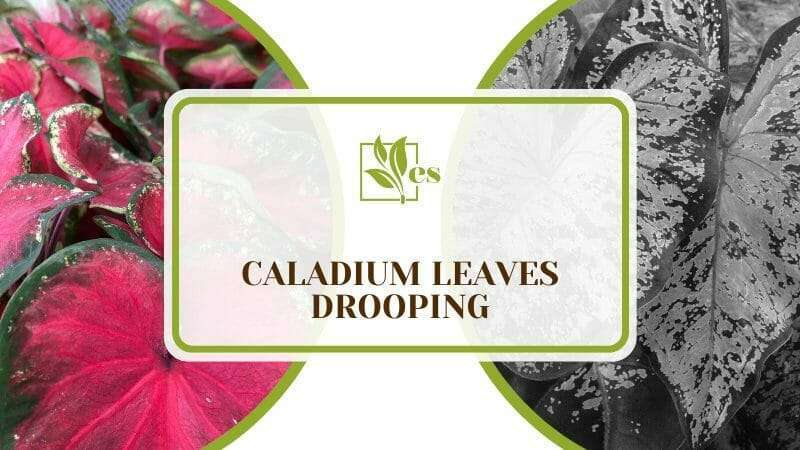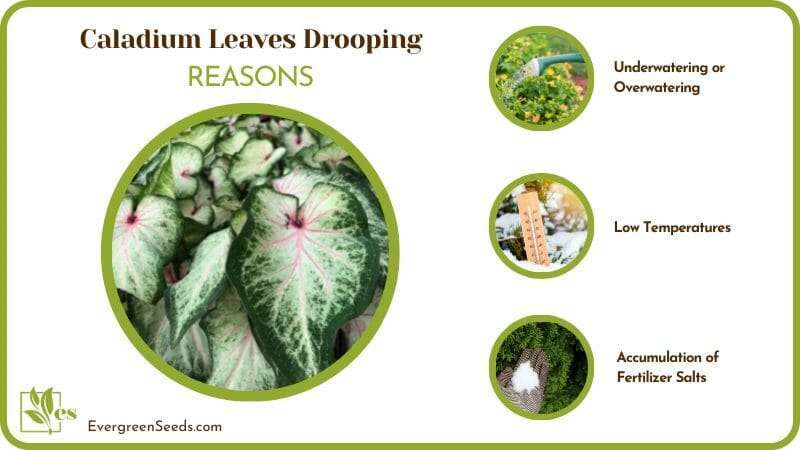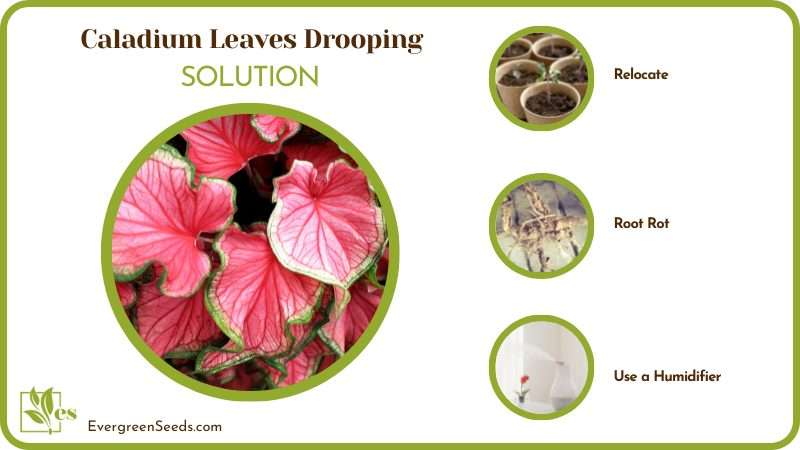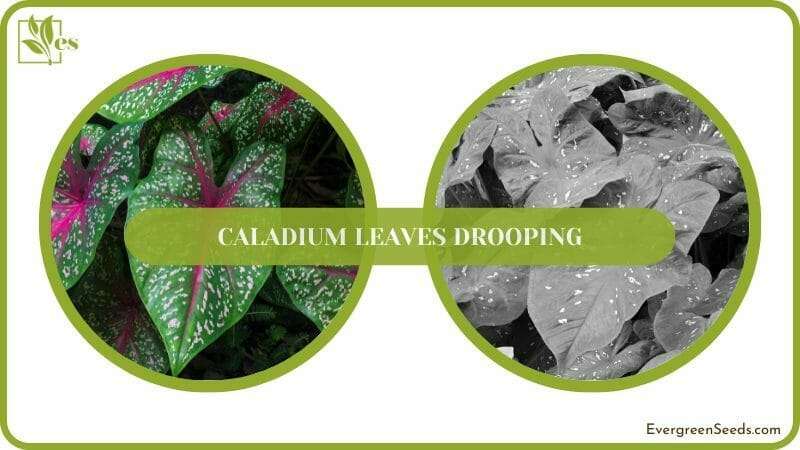Caladium leaves drooping are a constant worry for gardeners as this can be a sign of an unhealthy or unhappy plant. Gardeners often face this issue and are perplexed about how they can prevent it.

If you are having caladium leaf problems as well, read this article carefully and join us as we unravel the different causes and remedies for this problem.
Why Are My Caladium Leaves Drooping?
Underwatering, overwatering, or low temperatures are some of the most common reasons why caladium leaves droop. Aside from these, caladium leaves can also droop due to various other reasons. From being in an unsuitable environment to soil issues, the plant can be vulnerable when it has this symptom.
Here are the details and the causes for caladium leaves falling over.
– Underwatering or Overwatering
Caladiums require the soil to be just perfectly moist. The plant will not fare well with overwatering as well as underwatering.
If the plant isn’t receiving adequate water to keep the moisture intact, the leaves will droop and eventually wilt. At the same time, overwatering the caladium can make them drop their leaves and go dormant.
– Low Temperatures
Being tropical plants, caladiums detest extremely cold weather. Under this stress condition, you may find a caladium plant drooping. Temperatures below 65 degrees Fahrenheit makes the leaves droop and the plant collapse.
– Excessive Sunlight
If low temperatures are not an issue, caladium leaves can droop due to overexposure to sunlight as well. Excessive and direct sun’s rays can harm the plant, giving them a completely weary and wilted look.
– Accumulation of Fertilizer Salts
Excessive use of fertilizers can result in salt accumulation in the soil, which the caladium will not be able to take in. These salts gather at the roots, inhibiting the absorption of water as well.
You can spot salt build-up in the form of a white crust on the top layer of the soil. The build-up of salts over time can even lead to the caladium dying.
– Dehydrated Potting Mix
This is a commonly overlooked aspect of growing caladium plants. Moist, well-drained soil is essential for caladiums to thrive and be happy.
Take note that if they are placed in dry soil, these water-loving plants will definitely struggle to adapt. They react by making the caladium plant droop. The plants over time can lose their vigor and appear wilted.

Preventing
Maintaining proper soil conditions and laying off on the fertilizers will help prevent caladium plants from developing leaf problems. You can easily prevent caladium leaf problems by avoiding the most common gardening mistakes. Read on for more details.
– Maintain the Optimal Soil Condition
As discussed, caladium soil needs to be moist. Ensure you never let the soil go completely dry or let it sit in a water pool. Where dry soil can wilt the plant, sogginess can also lead to root rot and fungi growth.
Thus, keep the soil well-drained. You can alternatively apply a few inches of mulch to retain some moisture in the soil.
– Keep It Acidic
Caladium plants thrive in acidic soil. Test the pH level of the soil you are growing the plant in, and make sure it measures around 5.5. If the soil is not at this level, adding some mulch will help turn it acidic.
– Tackle Cold Wind Conditions
During the winter months when the temperatures are low and the wind velocity is high, move the caladium plant indoors. If the plant is outdoors in the soil and can’t be moved to warmer areas, cover it with garden sheets to retain heat and protect it from icy winds.
– Hardening Caladium Plants
Hardening is the process of progressively getting a plant acclimatized to sunlight and the outdoors, especially during the post-winter months. If you are relocating your caladium plant after the winter months, or from indoors to outdoors, do so slowly. The plant struggles to cope when they are abruptly moved to higher temperatures.
Start with an hour of sunlight a day and increase it gradually over five to six days. This will ensure that the leaves and stems do not get damaged due to sudden exposure to the sun.
– Avoid Excessive Use of Fertilizer
As mentioned earlier, salt accumulation can damage the caladium significantly. Limit the use of fertilizers to avoid this build-up. Also, prevent salt build-up with deep and long watering sessions instead of frequent and short watering.
Once every six months, leach the plant if it is potted. If the crust is hardened and severe, repot the plant. By doing so, you will wash away the salts into the soil.
– Mist the Leaves
Under hot and dry weather conditions, mist the leaves to naturally create a moist atmosphere. Spray water gently over the leaves and stems. The right time to do this would be in the afternoons.
Misting not only cools the plant but also helps to moisten the soil.
– Pot Them Right
If your caladium plants have been planted in pots, ensure they have good drainage holes. Prevent the holes from getting clogged by layering the bottom with pebbles or gravel.
Increase the drainage of the soil by mixing in pumice, perlite (or perlite substitutes) or lava rocks for soil aeration. Mulch can also help in keeping the soil moist and reduce the impact of extreme weather conditions.
– Plant Them in Indirect Sunlight
Although the caladium plant is tropical, the plant fares well in indirect sunlight. To develop beautiful green foliage, keep them away from direct sunlight. You can create a simple greenhouse effect with a garden sheet to protect the plant from harsh sun rays.
– Indoor Care
If you are growing your caladium indoors, block the direct rays of the sun by using blinds and curtains. You can also attach a UV blocking film to the window to reduce the effect of the sun’s rays while providing the plant with some indirect light.
– Provide Ventilation
Caladium plants are tropical and love a good bounty of air circulation. This is because air helps to regulate the temperatures around the plant. Thus, place caladiums in an area that is well ventilated with a good cross-movement of air. Avoid dingy corners if your plant is growing indoors.
How To Save a Dying Caladium
Relocating the plant and monitoring soil conditions are good ways to save a dying caladium. You can save a dying caladium plant by focusing on its vital care aspects. Here is a quick peek into what they are and how you can save your caladium.
– Relocate
If you notice your caladium dying, relocate the plant immediately. Keep them away from all sorts of direct heat. Some plants are sensitive to reflected heat from nearby shiny surfaces such as fences, glass windows, and paved stones.
A good remedy for this problem is to place them in a location with other plants. Doing this will help keep the plant cool and will also help in receiving indirect light.
– Root Rot
Prevent root rot by monitoring your soil moisture levels. Cut out the root that is affected to prevent the spread of rot.
When water pools at the base of the plant, the roots become flaccid and brown. The damage is visible in other parts of the plants as well in the form of yellowing leaves and caladium stems drooping.
– Pest and Disease
The best way to prevent spider mites, aphids and mealybugs from attacking your plant is to keep a close watch. These bugs can regularly attack your plant, multiplying by the dozen in a very short period of time.
Tackle pests present in the plant with a good organic insecticide. Wipe the leaves with water regularly to keep them at bay.

– Use a Humidifier
Save your dying caladium plant by providing it with humidity with the help of a humidifier. It can easily work towards increasing the moisture levels around the plant.
– Grow Them Close
If it is possible, grow your pots close to each other. This will naturally provide cool and moisture-rich air for the plants.
– Prune the Dead Leaves
A dead and droopy caladium leaf is not going to gain its original form back. Gently pruning the affected leaves will be the best action to take in this circumstance. Keeping them does not make sense as the plant will need to expand its energy for these dead leaves.
Use a garden snip to remove the curled and droopy leaves. The plant will be producing new leaves in no time so don’t worry about this. Make it a regular practice to prune the caladium, at least once every two or three weeks.













